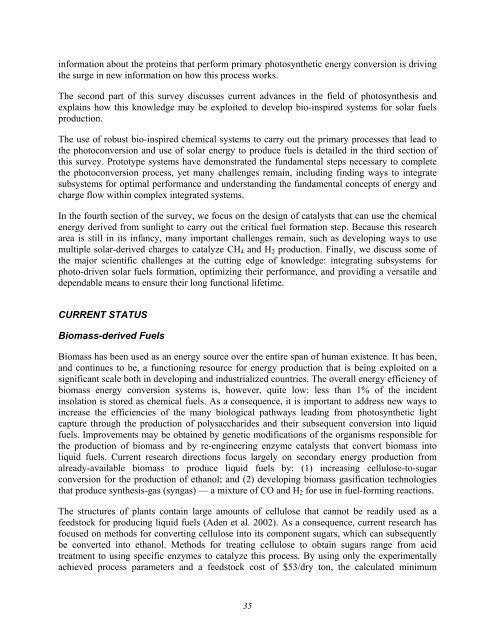Basic Research Needs for Solar Energy Utilization - Office of ...
Basic Research Needs for Solar Energy Utilization - Office of ...
Basic Research Needs for Solar Energy Utilization - Office of ...
Create successful ePaper yourself
Turn your PDF publications into a flip-book with our unique Google optimized e-Paper software.
in<strong>for</strong>mation about the proteins that per<strong>for</strong>m primary photosynthetic energy conversion is driving<br />
the surge in new in<strong>for</strong>mation on how this process works.<br />
The second part <strong>of</strong> this survey discusses current advances in the field <strong>of</strong> photosynthesis and<br />
explains how this knowledge may be exploited to develop bio-inspired systems <strong>for</strong> solar fuels<br />
production.<br />
The use <strong>of</strong> robust bio-inspired chemical systems to carry out the primary processes that lead to<br />
the photoconversion and use <strong>of</strong> solar energy to produce fuels is detailed in the third section <strong>of</strong><br />
this survey. Prototype systems have demonstrated the fundamental steps necessary to complete<br />
the photoconversion process, yet many challenges remain, including finding ways to integrate<br />
subsystems <strong>for</strong> optimal per<strong>for</strong>mance and understanding the fundamental concepts <strong>of</strong> energy and<br />
charge flow within complex integrated systems.<br />
In the fourth section <strong>of</strong> the survey, we focus on the design <strong>of</strong> catalysts that can use the chemical<br />
energy derived from sunlight to carry out the critical fuel <strong>for</strong>mation step. Because this research<br />
area is still in its infancy, many important challenges remain, such as developing ways to use<br />
multiple solar-derived charges to catalyze CH4 and H2 production. Finally, we discuss some <strong>of</strong><br />
the major scientific challenges at the cutting edge <strong>of</strong> knowledge: integrating subsystems <strong>for</strong><br />
photo-driven solar fuels <strong>for</strong>mation, optimizing their per<strong>for</strong>mance, and providing a versatile and<br />
dependable means to ensure their long functional lifetime.<br />
CURRENT STATUS<br />
Biomass-derived Fuels<br />
Biomass has been used as an energy source over the entire span <strong>of</strong> human existence. It has been,<br />
and continues to be, a functioning resource <strong>for</strong> energy production that is being exploited on a<br />
significant scale both in developing and industrialized countries. The overall energy efficiency <strong>of</strong><br />
biomass energy conversion systems is, however, quite low: less than 1% <strong>of</strong> the incident<br />
insolation is stored as chemical fuels. As a consequence, it is important to address new ways to<br />
increase the efficiencies <strong>of</strong> the many biological pathways leading from photosynthetic light<br />
capture through the production <strong>of</strong> polysaccharides and their subsequent conversion into liquid<br />
fuels. Improvements may be obtained by genetic modifications <strong>of</strong> the organisms responsible <strong>for</strong><br />
the production <strong>of</strong> biomass and by re-engineering enzyme catalysts that convert biomass into<br />
liquid fuels. Current research directions focus largely on secondary energy production from<br />
already-available biomass to produce liquid fuels by: (1) increasing cellulose-to-sugar<br />
conversion <strong>for</strong> the production <strong>of</strong> ethanol; and (2) developing biomass gasification technologies<br />
that produce synthesis-gas (syngas) — a mixture <strong>of</strong> CO and H2 <strong>for</strong> use in fuel-<strong>for</strong>ming reactions.<br />
The structures <strong>of</strong> plants contain large amounts <strong>of</strong> cellulose that cannot be readily used as a<br />
feedstock <strong>for</strong> producing liquid fuels (Aden et al. 2002). As a consequence, current research has<br />
focused on methods <strong>for</strong> converting cellulose into its component sugars, which can subsequently<br />
be converted into ethanol. Methods <strong>for</strong> treating cellulose to obtain sugars range from acid<br />
treatment to using specific enzymes to catalyze this process. By using only the experimentally<br />
achieved process parameters and a feedstock cost <strong>of</strong> $53/dry ton, the calculated minimum<br />
35
















